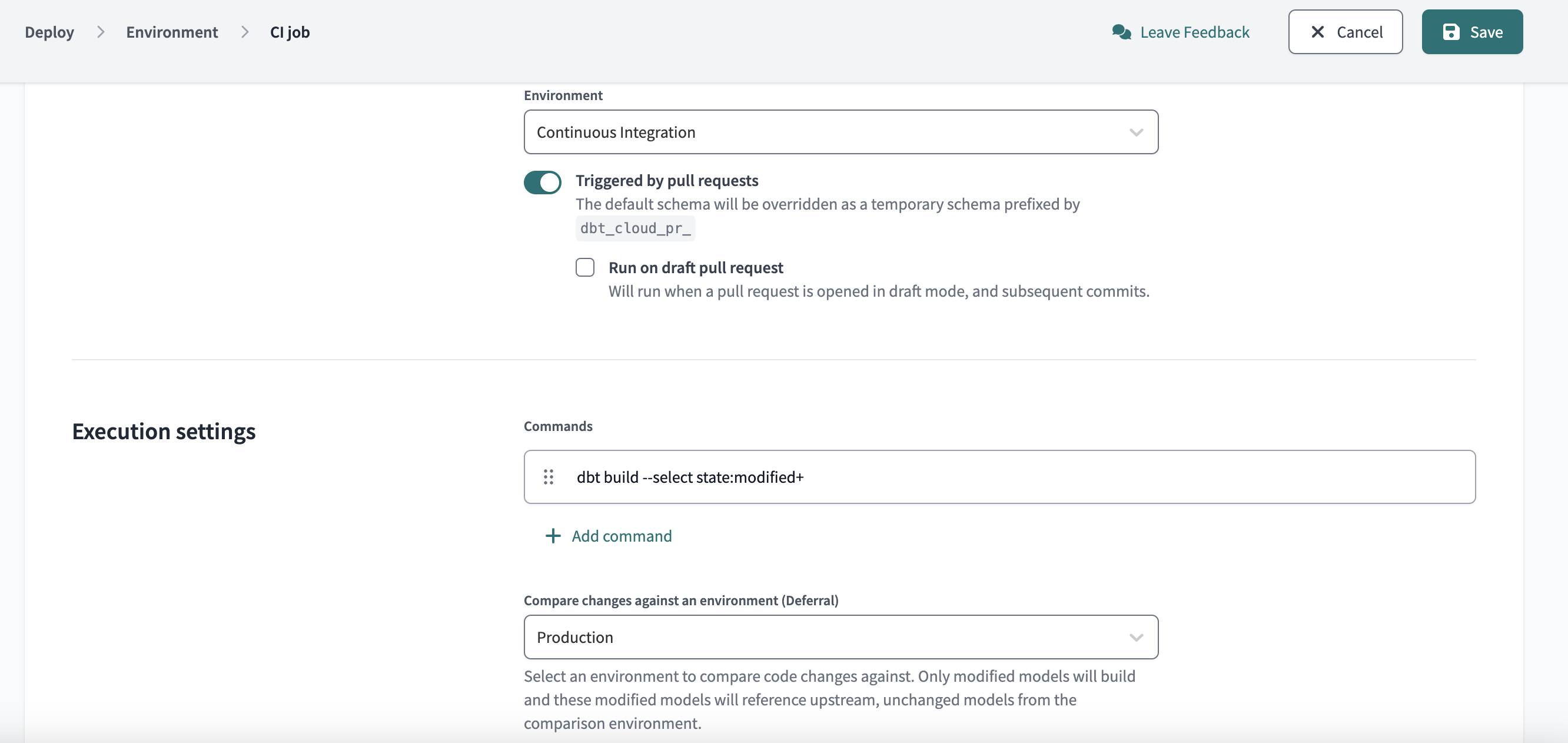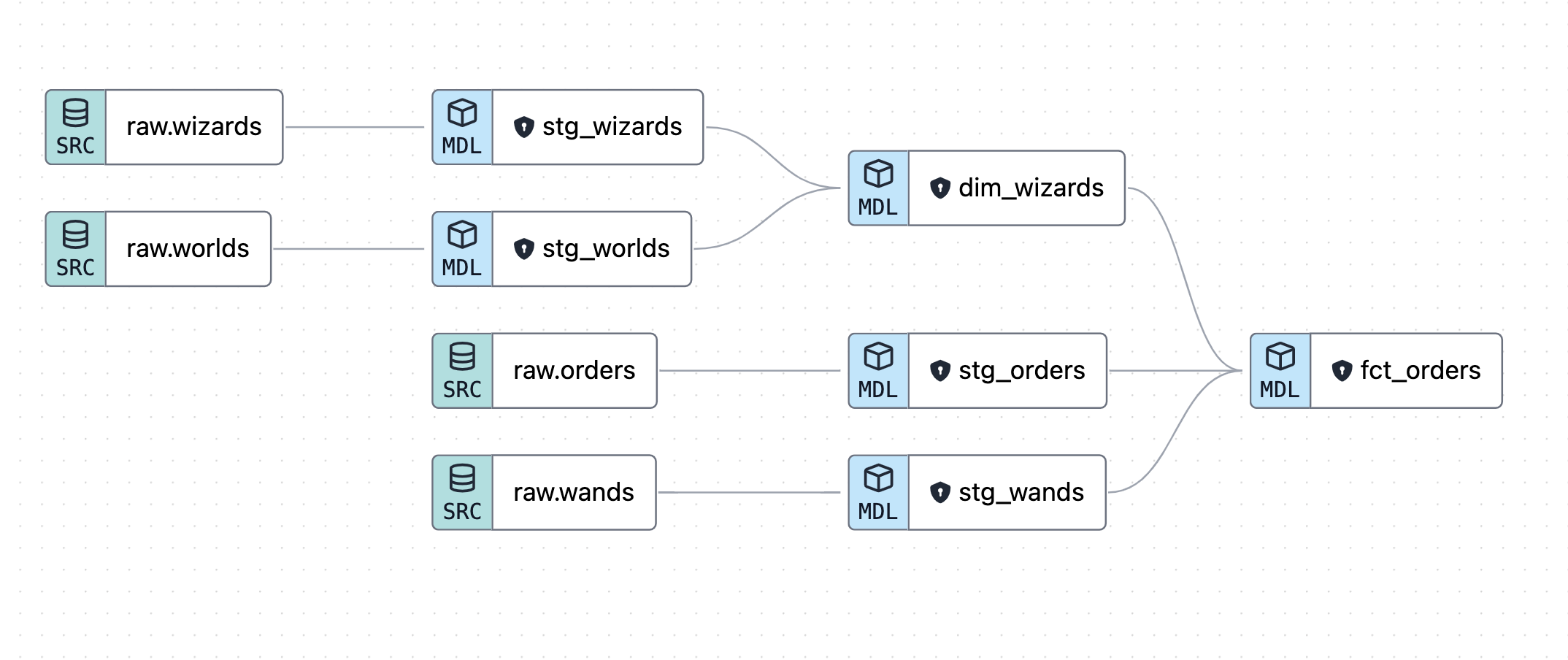Clone incremental models as the first step of your CI job
Before you begin, you must be aware of a few conditions:
dbt cloneis only available with dbt version 1.6 and newer. Refer to our upgrade guide for help enabling newer versions in dbt Cloud- This strategy only works for warehouse that support zero copy cloning (otherwise
dbt clonewill just create pointer views). - Some teams may want to test that their incremental models run in both incremental mode and full-refresh mode.
Imagine you've created a Slim CI job in dbt Cloud and it is configured to:
- Defer to your production environment.
- Run the command
dbt build --select state:modified+to run and test all of the models you've modified and their downstream dependencies. - Trigger whenever a developer on your team opens a PR against the main branch.
Now imagine your dbt project looks something like this in the DAG:
When you open a pull request (PR) that modifies dim_wizards, your CI job will kickoff and build only the modified models and their downstream dependencies (in this case, dim_wizards and fct_orders) into a temporary schema that's unique to your PR.
This build mimics the behavior of what will happen once the PR is merged into the main branch. It ensures you're not introducing breaking changes, without needing to build your entire dbt project.
What happens when one of the modified models (or one of their downstream dependencies) is an incremental model?
Because your CI job is building modified models into a PR-specific schema, on the first execution of dbt build --select state:modified+, the modified incremental model will be built in its entirety because it does not yet exist in the PR-specific schema and is_incremental will be false. You're running in full-refresh mode.
This can be suboptimal because:
- Typically incremental models are your largest datasets, so they take a long time to build in their entirety which can slow down development time and incur high warehouse costs.
- There are situations where a
full-refreshof the incremental model passes successfully in your CI job but an incremental build of that same table in prod would fail when the PR is merged into main (think schema drift where on_schema_change config is set tofail)
You can alleviate these problems by zero copy cloning the relevant, pre-existing incremental models into your PR-specific schema as the first step of the CI job using the dbt clone command. This way, the incremental models already exist in the PR-specific schema when you first execute the command dbt build --select state:modified+ so the is_incremental flag will be true.
You'll have two commands for your dbt Cloud CI check to execute:
- Clone all of the pre-existing incremental models that have been modified or are downstream of another model that has been modified:
dbt clone --select state:modified+,config.materialized:incremental,state:old
- Build all of the models that have been modified and their downstream dependencies:
dbt build --select state:modified+
Because of your first clone step, the incremental models selected in your dbt build on the second step will run in incremental mode.
Your CI jobs will run faster, and you're more accurately mimicking the behavior of what will happen once the PR has been merged into main.
Expansion on "think schema drift" where on_schema_change config is set to fail" from above
Imagine you have an incremental model my_incremental_model with the following config:
{{
config(
materialized='incremental',
unique_key='unique_id',
on_schema_change='fail'
)
}}
Now, let’s say you open up a PR that adds a new column to my_incremental_model. In this case:
- An incremental build will fail.
- A
full-refreshwill succeed.
If you have a daily production job that just executes dbt build without a --full-refresh flag, once the PR is merged into main and the job kicks off, you will get a failure. So the question is - what do you want to happen in CI?
- Do you want to also get a failure in CI, so that you know that once this PR is merged into main you need to immediately execute a
dbt build --full-refresh --select my_incremental_modelin production in order to avoid a failure in prod? This will block your CI check from passing. - Do you want your CI check to succeed, because once you do run a
full-refreshfor this model in prod you will be in a successful state? This may lead unpleasant surprises if your production job is suddenly failing when you merge this PR into main if you don’t remember you need to execute adbt build --full-refresh --select my_incremental_modelin production.
There’s probably no perfect solution here; it’s all just tradeoffs! Our preference would be to have the failing CI job and have to manually override the blocking branch protection rule so that there are no surprises and we can proactively run the appropriate command in production once the PR is merged.
Expansion on "why state:old"
For brand new incremental models, you want them to run in full-refresh mode in CI, because they will run in full-refresh mode in production when the PR is merged into main. They also don't exist yet in the production environment... they're brand new!
If you don't specify this, you won't get an error just a “No relation found in state manifest for…”. So, it technically works without specifying state:old but adding state:old is more explicit and means it won't even try to clone the brand new incremental models.


